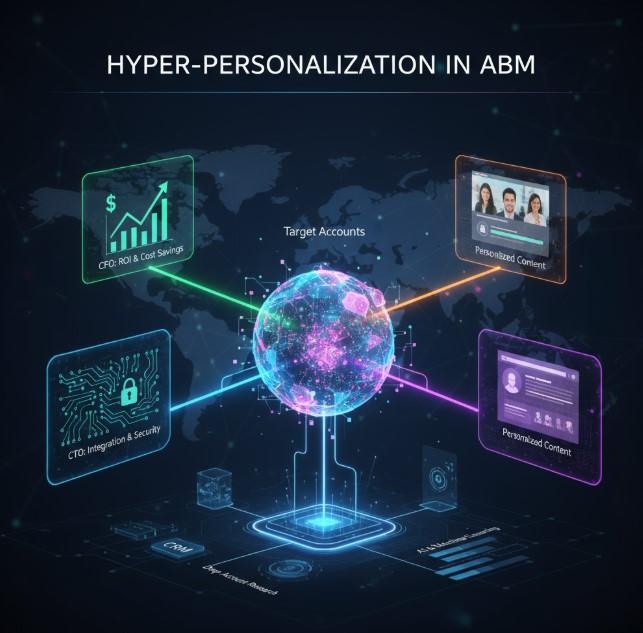Hyper-Personalization in ABM: The Key to Engaging High-Value Accounts

In 2025, B2B buyers are bombarded with endless ads, emails, and social posts. Standing out requires more than generic personalization like "Hi [First Name]." For Account-Based Marketing (ABM), the bar is much higher. Success depends on hyper-personalization—tailoring campaigns at the account, buying committee, and even individual decision-maker level.
This blog explores what hyper-personalization in ABM really means, the challenges B2B marketers face, strategies to implement it effectively, and how AI and intent data are transforming personalization at scale.
What is Hyper-Personalization in ABM and Why It Matters
Hyper-personalization is the practice of using real-time data, behavioral signals, and AI-driven insights to deliver highly relevant experiences to key accounts.
Unlike traditional personalization (name, company, or industry), hyper-personalization focuses on:
- Business challenges unique to the account
- Buying stage signals
- Role-specific priorities (CFO vs. CMO vs. CIO)
- Context-driven messaging and offers
Why it matters:
- 74% of B2B buyers choose the vendor that first demonstrates real understanding of their needs (Forrester).
- Personalized campaigns drive 6x higher engagement compared to generic ABM outreach.
- It strengthens trust and accelerates deal velocity.
Key Challenges in Hyper-Personalization
- Data Quality & Access – Inaccurate or incomplete intent and firmographic data can derail personalization.
- Scalability – Building unique campaigns for dozens of accounts can overwhelm teams.
- Technology Overload – Too many disconnected ABM tools make orchestration difficult.
- Content Alignment – Producing role-based, stage-specific assets requires high content velocity.
- Measurement Complexity – Proving ROI from personalized campaigns across multiple accounts is challenging.
Proven Strategies to Implement Hyper-Personalization in ABM
1. Leverage Intent Data for Real-Time Insights
Track what topics target accounts are researching online. Tools like 6sense, Bombora, and Demandbase help marketers align messaging with active buying signals.
2. Map Buyer Committees, Not Just Accounts
Engage each decision-maker with content relevant to their priorities:
- CIO → security, scalability
- CMO → customer experience, ROI
- CFO → cost efficiency, TCO
3. AI-Driven Content Personalization
Use AI platforms to dynamically adapt landing pages, ads, and email sequences based on visitor profile and behavior.
4. Scalable 1:1 Campaigns with Automation
Adopt tiered ABM strategies:
- Tier 1: Full 1:1 hyper-personalization for top accounts
- Tier 2: 1:few with vertical-specific messaging
- Tier 3: 1:many with lighter personalization
5. Account-Centric Orchestration
Align SDRs, sales, and marketing teams around account-specific plays to deliver a consistent experience across touchpoints.
The Future of Hyper-Personalization in ABM (2025 & Beyond)
The next evolution of ABM personalization will be powered by:
- Predictive AI: Anticipating needs before accounts even express them.
- Generative AI: Scaling personalized content creation for dozens of accounts.
- Omnichannel Consistency: Seamless personalization across email, LinkedIn, ads, webinars, and events.
- Real-Time Orchestration: Adjusting campaigns instantly as buying signals change.
In short, ABM is moving from "right message, right person, right time" → to "right message, right person, right time, right context."
Pro Tips for ABM Marketers
- Build an account personalization matrix mapping roles, pain points, and messaging.
- Reuse content frameworks across tiers—don’t reinvent the wheel for each account.
- Track personalization ROI with metrics like engaged accounts, pipeline influence, and velocity.
- Involve sales early—ABM personalization is strongest when marketing + sales speak with one voice.
Conclusion
Hyper-personalization isn’t optional in ABM—it’s the differentiator that wins high-value deals. By aligning data, AI, and content strategy, B2B marketers can move beyond surface-level personalization and deliver experiences that resonate deeply with decision-makers.
- Art
- Causes
- Crafts
- Dance
- Drinks
- Film
- Fitness
- Food
- Games
- Gardening
- Health
- Home
- Literature
- Music
- Networking
- Other
- Party
- Religion
- Shopping
- Sports
- Theater
- Wellness


